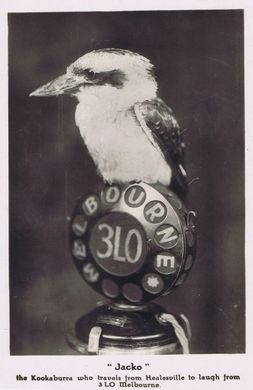1924
Behind the scenes in Australian Radio
In 1924 several Melbourne stations commenced broadcasting, namely 3AR on the 26th January and 3LO 13th October.
In 1924 the Australian population is 5.6M
At this point I had better explain the system of Call Signs used in Australia. Very basic. They are 3 characters with the first a number identifying the state, followed by two letters. 2 - New South Wales & ACT, 3 - Victoria, 4 - Queensland, 5 - South Australia, 6 - Western Australia, 7 - Tasmania, 8 - Northern Territory.
I mentioned that 2SB and 2FC were licenced. In order to fund 'wireless', an annual licence fee of ten shillings (approx. $1.00) was imposed by the Government, on listeners. At the time these stations commenced, there were approximately 1,400 licenced listeners. Initially a 'Sealed Set' system was adopted, whereby the tuning was locked to a single station and the listener paid a fee to that station. Fortunately this was scrapped and a licence system was introduced and of course increased in cost at various times and was joined by a Viewers licence after Television commenced in Australia in 1956. The licences would then be combined in later years and the licencing wasn't phased out until 1974.
Radio stations in 1924 were divided into A, B & C Class stations.
'A' Class stations received the lions share of the Listeners Licence fees, B Class received no portion as they were deemed to be self supporting through the use of advertising, they were 'Commercial Stations'.
C class were supposed to be sponsored but no C class licences were ever issued.
Wireless content kicked off with music and information as well as dramatic performances either live within studios or live on the stage and relayed.
In Melbourne, Adelaide, Brisbane, Perth and Hobart we see the same growth of stations and the need for content. The larger stations formed partnerships with local acting groups and formed their own 'Players' to regularly write and perform live on air. Early Radio Drama and Comedy had a fair percentage of influence from British Music Hall traditions. There was a healthy stage circuit with several competing groups bringing acts between England and Australia. Those Music Hall traditions were still an influence on Australian radio and then television well in to the 1960's.
In 1924 the Australian population is 5.6M
At this point I had better explain the system of Call Signs used in Australia. Very basic. They are 3 characters with the first a number identifying the state, followed by two letters. 2 - New South Wales & ACT, 3 - Victoria, 4 - Queensland, 5 - South Australia, 6 - Western Australia, 7 - Tasmania, 8 - Northern Territory.
I mentioned that 2SB and 2FC were licenced. In order to fund 'wireless', an annual licence fee of ten shillings (approx. $1.00) was imposed by the Government, on listeners. At the time these stations commenced, there were approximately 1,400 licenced listeners. Initially a 'Sealed Set' system was adopted, whereby the tuning was locked to a single station and the listener paid a fee to that station. Fortunately this was scrapped and a licence system was introduced and of course increased in cost at various times and was joined by a Viewers licence after Television commenced in Australia in 1956. The licences would then be combined in later years and the licencing wasn't phased out until 1974.
Radio stations in 1924 were divided into A, B & C Class stations.
'A' Class stations received the lions share of the Listeners Licence fees, B Class received no portion as they were deemed to be self supporting through the use of advertising, they were 'Commercial Stations'.
C class were supposed to be sponsored but no C class licences were ever issued.
Wireless content kicked off with music and information as well as dramatic performances either live within studios or live on the stage and relayed.
In Melbourne, Adelaide, Brisbane, Perth and Hobart we see the same growth of stations and the need for content. The larger stations formed partnerships with local acting groups and formed their own 'Players' to regularly write and perform live on air. Early Radio Drama and Comedy had a fair percentage of influence from British Music Hall traditions. There was a healthy stage circuit with several competing groups bringing acts between England and Australia. Those Music Hall traditions were still an influence on Australian radio and then television well in to the 1960's.
